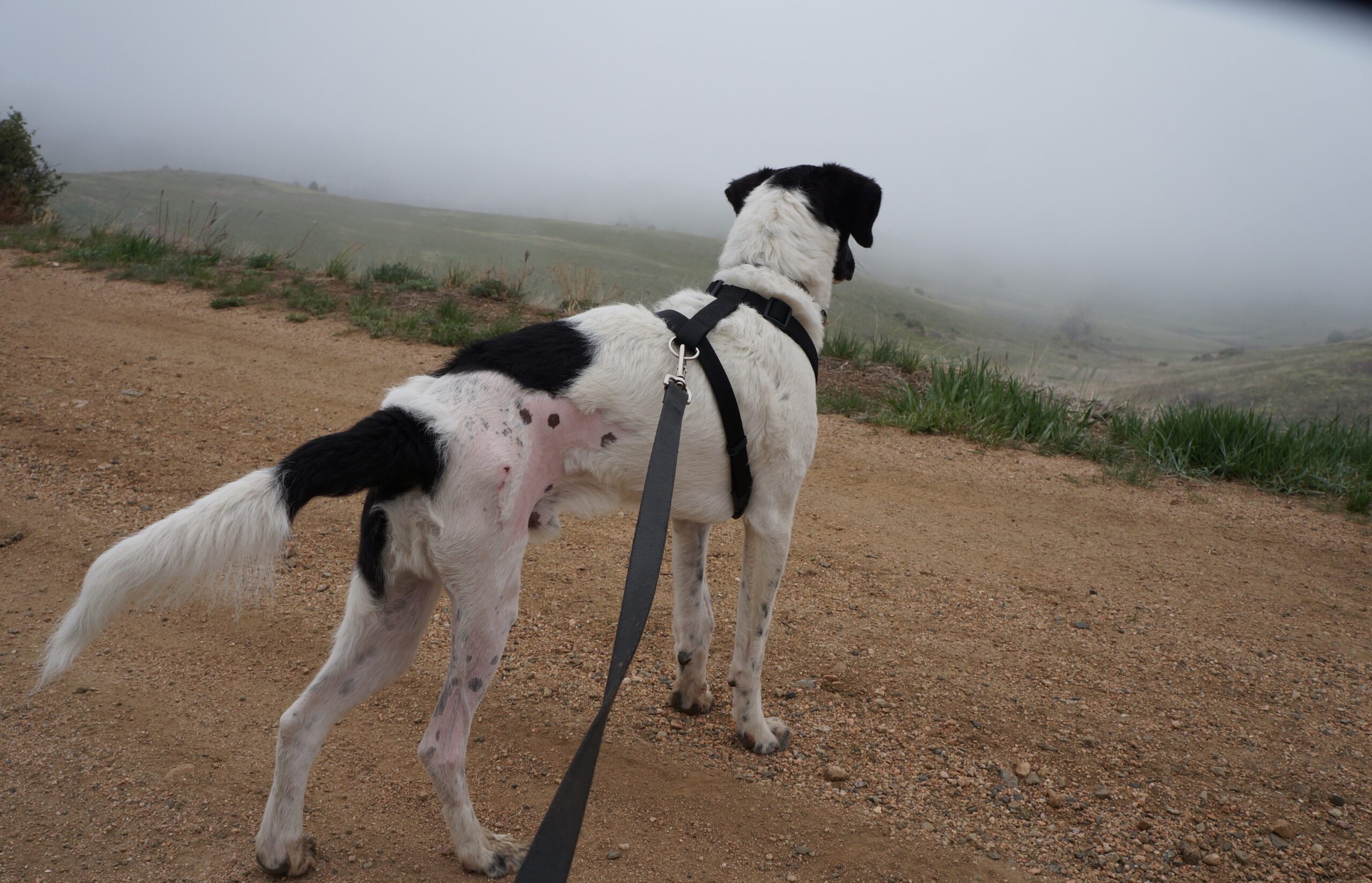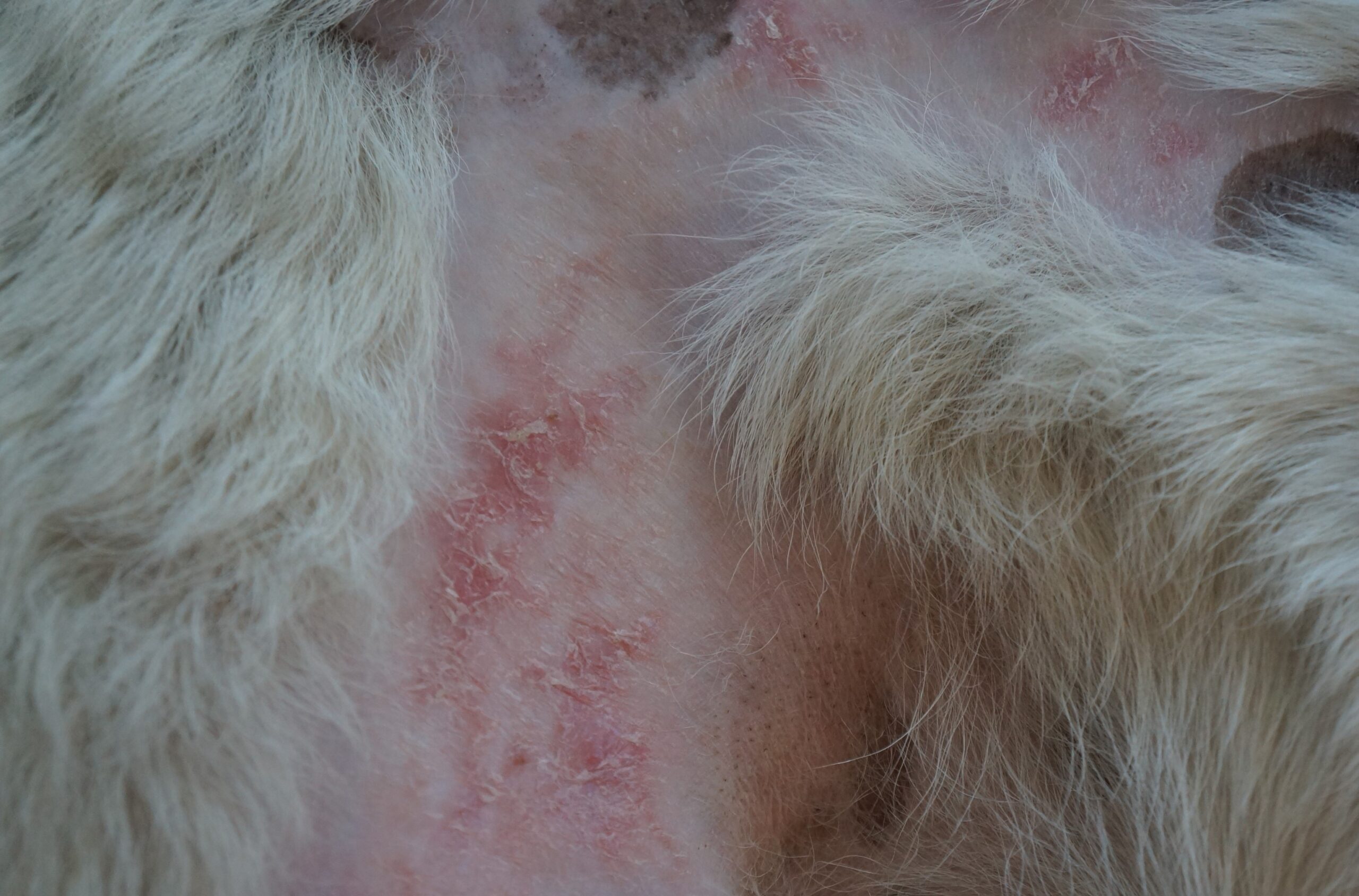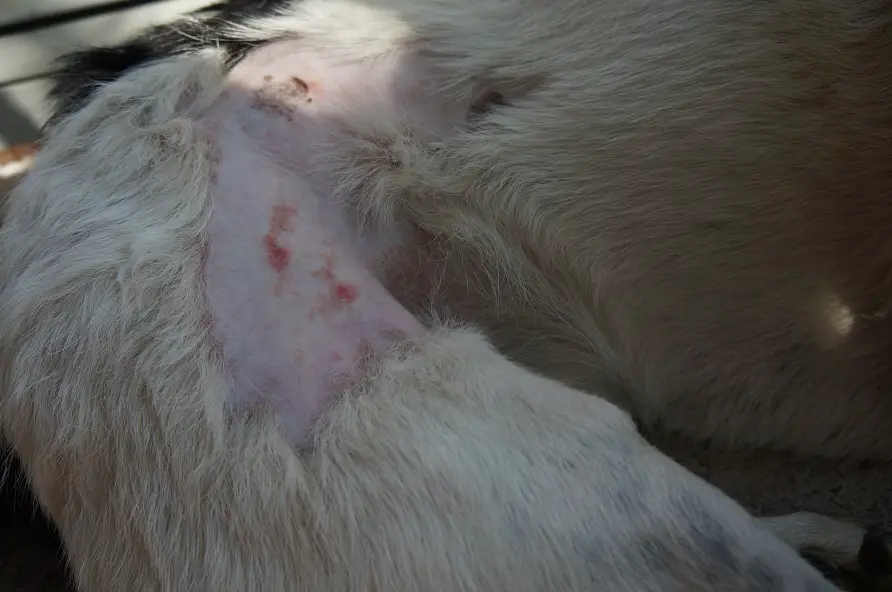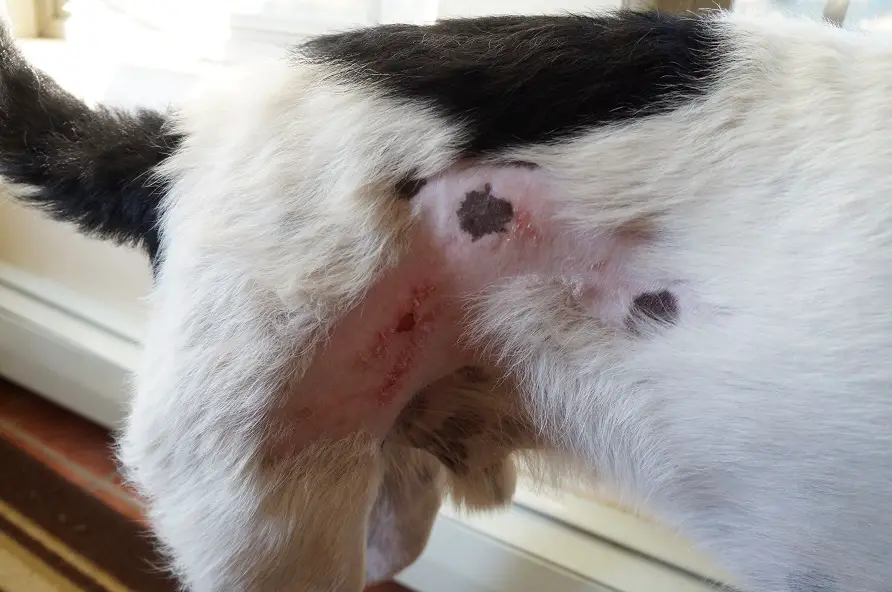I still need to publish a real post about Mr. Stix's full backstory, but this feels more pressing. For nearly 18 months, Mr. Stix's permanent nakey spot (from unknown injuries before he was rescued, including 15 fractures and this big patch of coat missing) has featured several inflamed, peeling areas. Initially I tried to fix it myself at home with things like aloe vera, vaseline, a veterinary ointment called animax that the shelter had give us while we fostered him most of 2019, etc. It's sort of a combination of steroids, antibacterial, and antifungal stuff. I took him to see our main veterinarian in spring 2020, when there was a 2-month wait to get into see a board-certified veterinary dermatologist. It has been quite a journey since then, and it's nowhere near over. Here's my best advice for dogs with skin issues.
More...
Before I tell the ongoing saga with Mr. Stix's skin. Here is my best advice for dogs with skin problems.
- See a board-certified veterinary dermatologist as soon as you can. Yes, your main veterinarian can probably help. Honestly, though, it's best to go right to the top experts.
- Agree to whatever skin scrapings / cytology the veterinary dermatologist recommends. This provides information about what types of secondary infections currently grow on your dog's damaged skin.
- Do NOT assume every skin issue is allergies. It often is some sort of allergic process, but NOT always. Assuming so (and acting accordingly may only delay real solutions and subject your dog to all kinds of quack advice and home remedies).
- Buy the best quality fish oil and Vitamin E supplements you can afford, if it's recommended for your particular case of a dog with skin issues.
- When necessary, agree to the skin biopsies (yes, like minor surgery) and have them reviewed by a veterinary pathologist that specializes in dogs with skin issues. The one we used is at Texas A&M.
- Follow your veterinary dermatologist's advice and plans, and keep the faith. These dogs with skin problems often don't improve quickly. (I need to take my own advise. See below.)
Mr. Stix's Story as a Dog with Skin Problems
This is what Mr. Stix's nakey spot looks like when it's normal. Photo from May 2019 soon after his hip surgery. The bald patch is permanent. That's not the issue.
This is how bad the red / peeling areas got in mid-2020 when we saw our main veterinarian, who added a low-dose of oral Vitamin E and some topical too and told me to keep using the animax.
This is how it looked when Mr. Stix first saw the board-certified veterinary dermatologist in early August 2020, but the specialist had me STOP the animax and instead use a prescription anti-bacterial ointment (mupirocin). He also added a better quality oral fish oil and continue both topical and oral Vitamin E (but at a higher dose twice a day). We knew from the skin scrapings / cytology they did onsite that Mr. Stix had a bacterial infection.
But, without the daily topical steroids (which long term are a bad idea), Mr. Stix's skin got much, much worse -- even breaking open and scabbing over.
Our veterinary dermatologist had recommended doing the skin biopsies right away in August 2020. I *almost agreed to it then, but I was VERY worried about the cuts resulting in skin that would NOT heal. And, I figured it was at least worth a try to use the prescription antibiotic ointment and other supplements and stuff.
But, by around Thanksgiving, it was clear we had to do the biopsy. That photo is kind of gruesome, so you can see it here, if you want. I wish I had done the biopsy sooner. I feel like I wasted time from August through November.
Post-Biopsy Diagnosis
As I expected, despite all the know-it-alls trying to tell me it was an allergic issue, it turns out that Mr. Stix instead has an autoimmune condition called erythema multiforme. The veterinary dermatologist and pathologist believe it was triggered by the trauma of his earlier injuries. They don't think it is life-threatening. In addition, they don't think it will spread to other areas of his skin. Just the already damaged, permanent nakey spot.
With that information in hand, we updated the treatment plan to include a topical, non-steroidal anti-inflammatory ointment (tacrolimus -- often pricey, but we used a Good RX coupon at Costco to get the cost down). They use a version of this medication orally for people who have had various kinds of transplants. It's the smallest / safest option for treatment, and that's where we started.
I was so hopeful it would work at the once-daily application, but the skin still didn't heal completely.
So, in early 2021, we started applying it twice daily on the advice of our veterinary dermatologist.
But, it still hasn't healed completely. It often improves a lot and then comes roaring back, so we had another appointment to see the specialist last week. We had to try something new.
Enter the Big Immune-Suppressing Drug
Despite my concerns and form of veterinary PTSD about major immune suppression drugs (after our experiences with Lilly), I agreed last week to add oral cyclosporine, which is also a drug that people get after various transplants. Mr. Stix would need to take it daily for life.
It smells like it's made from skunk *butts. Each gel-cap pill is individually packaged, and you keep them in the freezer because that can help with nausea it can cause (since it's recommended you give on an empty stomach).
I found some good info on this med, and our veterinary dermatologist assured me that it has been safely used in veterinary medicine for like 20+ years, etc.
The med only comes in doses of 25 mg, 50 mg, and 100 mg, and at his size Mr. Stix's ideal dose is around 88 mg once a day. So we went with 75 mg (25+50) to err on the lower side.
It takes like 3-7 days for the med to build up in the blood to therapeutic levels, but it takes more like 4-6 weeks to know if it's going to help the skin (or not).
We made it to day 4, then the barfing started.
On day 5, things got scary!
- Mr. Stix began acting weird about finding a place to potty, circling and circling and circling, like he’d forgotten what he was doing.
- Rather than play, he stood with his head in the tall grass in the backyard, kind of zoning out, almost like he gone suddenly senile.
- About 90 minutes after his pills on day 5, he had a very unusual afternoon poop (again acting weird and seeming to struggle).
- Then, he came back inside, but still seemed restless, so I gave him a small snack of dry food.
- He was still crying off/on, so I took him back outside, and he strained to poop, but just a few drops of what looked like water came out.
- I brought him back inside, then he went to hide / cry in the hall bathroom, which is something he has NEVER done -- even after his many injuries and surgeries.
That freaked me out. While in the process of contacting our veterinary dermatology team, Mr. Stix put himself to bed in his crate -- basically laying flat on his side, looking very sad.
Thankfully, I heard back from our team pretty quickly with 2 recommendations:
- STOP giving him the med for a week.
- Bring him to the ER, if I was worried or things got worse.
The good news is that he did not get worse, so we avoided the ER. He does seem better-ish, but he once again vomited in the afternoon his first day without the med.
Today is his second day without it. He mostly seems okay, so I'll be interested to see if he gets barfy again.
Pet Insurance Baloney
Mr. Stix's medical records from the shelter include that he had an ear infection after likely spending 6 weeks alone and starving (with 15 fractures and a chunk of skin missing). For that reason, our pet insurance excludes ALL DERMATOLOGY issues as pre-existing. Gah! That seriously pisses me off.
So, we have gotten exactly ZERO help with any of the expenses related to his skin issues ... even though they are immune-mediated and NOT your typical allergy-driven stuff that often cause ear and skin issues in dogs.
Anxiety
I wish I could say that this is all going to be fine, but I just don't know. Yet, I feel like I just have to accept that the skin will never fully heal. It's tough because seeing his raw spots up close while applying the topical med twice a day and topical Vitamin E once a day causes me so much angst and anxiety.
I supposed to check in with our veterinary dermatology team next week to confirm that Mr. Stix's weirdness and apparent suffering has improved.
It took a lot of convincing to get Mr. Champion of My Heart to agree to try the cyclosporine, so even if the specialist comes back and recommends maybe a lower dose, I doubt we'll want to risk it. Mostly because Mr. Stix sure seemed to be having some neurology issues to me. After the Lilly situation, I just cannot do that again.
Because, yeah ...
He is only 3 years old. I don't want to make anything worse. It honestly felt like I'd poisoned him.
The good news is that most of the time his skin doesn't seem to hurt or itch or anything -- though I do have pain meds, if he needs them. It mostly just looks bad. He has to wear a no-lick collar for about 20 minutes after I apply his meds so that he doesn't lick it off.
His nakey spot is prone to sunburn anyway. The topical tacrolimus increases the risk of burning, so I used his earlier sun-reflecting coat (which started to look ragged) as a pattern and sewed him a new / light sun protection coat. He looks very cute in it.
So that's our long, sad story about Mr. Stix skin. It isn't allergies. It has NOTHING to do with his food. And, no, I'm not going to smear him with honey.
Maybe there is a way forward, but I just don't see it right now --- partly from pandemic exhaustion and stress, partly because we recently lost my godfather, and partly because I'm still recovering from handing off our latest foster puppy on Monday. Here is her lovely muppet face to end on a better note. She got adopted Tuesday.









What a hard saga this has been for you and Mr. Stix. True had lick granulomas for years and years and nothing we did helped her. Some vets said it was behavioral, others said it was infection and that the meds for her dust mite allergy lowered her immune system (we got off of those). I can feel your pain. I tried everything – OCD meds, CBD products. I finally got her MediMitts that covered her sores (on her hocks). They worked better than anything and she didn’t pull them off. I still have one she wore and I will sniff it occasionally because it smells like her. She’s been gone 2 years now.
I know you said you aren’t smearing him with honey. I will give you an event that happened with our Maine Coon, Merlin, who has been battling FIP since early April. I joined a group and got a treatment that while it kicked FIP butt, it also caused purulent sores – a reaction to the medication. One got SO BAD it was gooey and the size of a quarter – maybe larger. My vet told me to put sugar on it. I was like, huh? It seems bacteria doesn’t survive in sugar. I looked it up and it’s used some for diabetic sores. Within 5 days his oozy sore was a scab about the size of a nickel. It’s the only one we had to use sugar on. I used an antimicrobial/anti fungal wipe before every injection and after the injection. I also used it on the existing sores which, thank the Lord, didn’t get very large. He’s in observation now and doing well.
I will send a prayer up for you and Mr Stix.
There is some type of honey (can’t remember the name at the moment) that some people use for antibacterial purposes. Since what’s happening is coming from the inside out, I don’t think it would help … since we’ve long since solved the bacterial secondary infection. Plus, I have a hard enough time getting him NOT to lick the topical meds. He’s think HONEY was a real treat. Stinker!